What is a Moroccan tajine?
The Moroccan Tagine is a full tradition in itself.
The tajine, a type of stew in which vegetables and meat are cooked, is an iconic dish of Maghreb cuisine, notably in Morocco. It is also named for the cooking equipment, a conical-shaped container. Although popular in Algeria and Morocco, the tajine is of Berber origin, and experts agree that the tastiest tajines may be found in the Berber area.
Traditionally, tajines are formed of clay, and the meal is steamed and stewed in a hollow plate topped with a conical lid after being placed in the tajine and boiled over low heat. The end result is incredible: the food cooked in this tajine meal is really delectable and melts in your tongue, much to the joy of food lovers, particularly for meat that retains all of its suppleness. The pointed form of the cover allows for cooking without water, preserving all of the tastes of the dish. The steam from the meal condenses on the tajine dish’s cover and drips back onto the food, moistening it.
A traditional Moroccan family meal
Tagine (Tajine) is a traditional family and social dish. It may also be eaten at festivals and special events to bring the entire family together for a traditional dinner. The family members are seated around a circular table with the tajine in the center. The cover is lifted, and each individual uses a slice of bread to pick directly into the dish. Because, it goes without saying, Moroccans eat almost everything with bread.
There are several options.
When referring to food, the term tajine refers to food that has been prepared in the tajine dish. There are several tajines to choose from, including chicken, beef, lamb, and fish tajines, as well as fruit and sweet-savory tajines. There’s even a vegan tajine! As previously said, slow cooking in the tajine allows each meal to absorb the fragrances of the others. Each family has its unique formula, but the goal is the same.
Chicken Tagine
Chicken tagine is a typical Moroccan cuisine that consists of braised chicken chunks with spices, garlic, onion, olives, and preserved lemons. It’s impressive but simple to prepare.
This is my favorite chicken tagine, a classic Moroccan meal of braised chicken pieces with spices, garlic, onion, olives, and preserved lemons that I adapted from Cook’s Illustrated. It’s elegant enough for guests yet simple enough to prepare on a not-too-busy weeknight. The term tagine alludes to the shallow clay pot with a cone-shaped lid in which the meal is typically cooked, but it is not required to make it. I use a big cast-iron braiser, but a wide Dutch oven or a heavy-bottomed covered pan can also suffice.
This recipe does not use preserved lemons, which are a specialty product that can be difficult to come by. Lemon zest and fresh lemon juice, on the other hand, give a tangy sharpness to the meal. Serve the chicken on a platter or individual plates over couscous.
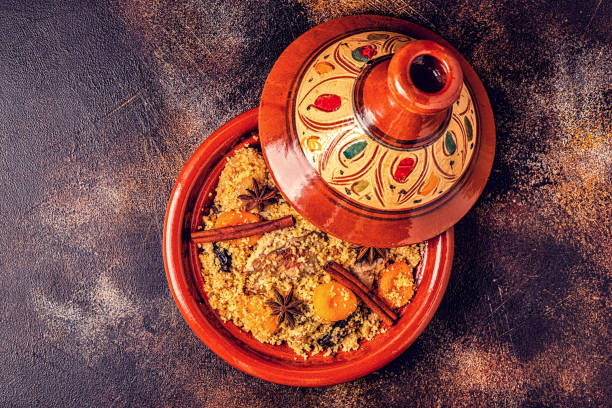
WHAT YOU WILL REQUIRE TO MAKE CHICKEN TAGINE
While an entire cut-up chicken may be used for chicken tagine, I like bone-in, skin-on chicken thighs. They give a substantial amount of meat and stay soft even when slightly overdone, while the bones and skin add depth of flavor and richness to the sauce (though the skin is removed midway through cooking). I occasionally remove the meat off the bone before serving since it makes it simpler and more appealing for the kids to eat, but serving the chicken on the bone is conventional.
HOW TO MAKE CHICKEN TAGINE
Set aside after thoroughly mixing.
Squeeze the lemon. Set aside 1 teaspoon of lemon zest and 1 chopped garlic clove.
Season the chicken pieces on each side with 2 tablespoons salt and 1/2 teaspoon pepper.
In a large Dutch oven or heavy-bottomed pan, heat the oil over medium-high heat until it begins to smoke. Brown the chicken pieces in a single layer, skin side down, for about 5 minutes, or until deep golden.
Moroccan Chicken Tagine
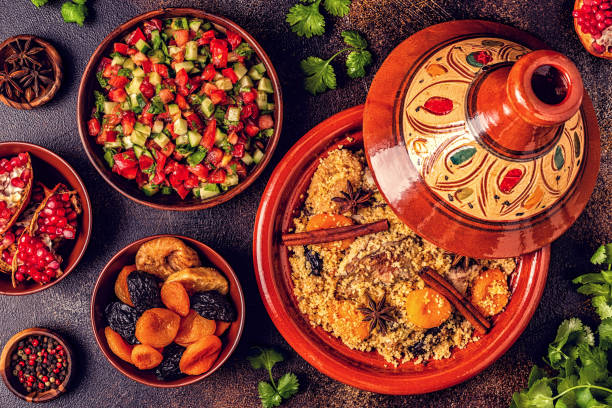
Turn the chicken pieces over with tongs and brown the other side for another 4 minutes. how to cook a chicken tagine.
Place the chicken in a large bowl and, when cool enough to handle, remove the skin and discard it.
Remove and discard all but a tablespoon of fat from the pan, lower the heat to medium and add the onion.
Cook, stirring periodically, for 5 to 7 minutes, or until the edges are browned but hold their shape (add a few tablespoons of water if the pan gets too dark).
Cook, stirring constantly, until the remaining minced garlic is fragrant, about 30 seconds. Combine the spices and flour in a mixing bowl.
Cook, stirring regularly, for 30 seconds, or until aromatic.
Scrape the bottom of the pan with a wooden spoon to release any browned pieces before adding the broth, honey, remaining lemon zest, and 1/4 teaspoon salt.
Return the chicken (together with any collected liquids) to the pan, decrease the heat to medium-low, cover, and cook for 10 minutes.
Scatter the carrots about the chicken, cover, and cook for another 10 minutes, or until the chicken is cooked through and the carrots are tender-crisp.
Combine the olives, garlic-zest combination, cilantro, and 1 tablespoon lemon juice in a mixing bowl.
Stir to blend and season with salt, pepper, and additional lemon juice if needed.
Serve alongside couscous.
Chicken tagine is a typical Moroccan cuisine that consists of braised chicken chunks with spices, garlic, onion, olives, and preserved lemons. It’s impressive but simple to prepare.
4 to 6 servings
Preparation Time: 15 Minutes
Time to cook: 45 minutes
1 hour in total
Components
- 1 tablespoon paprika
- 1 teaspoon cumin powder
- a quarter teaspoon
- cayenne pepper
- 1/2 teaspoon ginger
- powder
- 1/2 teaspoon coriander
- powder
- 1/4 teaspoon cinnamon
- powder
- 1 tangerine our lemon
- 8 bone-in, skin-on chicken
- thighs (about 4 pounds),
- trimmed of superfluous
- skin and fat (see note)
- salt and freshly ground
- black pepper
- 1 teaspoon olive oil
- 1 big yellow onion, halved and sliced into 1/4-inch
- slices
- 2 tbsp. all-purpose flour
- 14 cup chicken broth
- 2 teaspoons honey
- 2 big or 3 medium carrots,
- peeled and sliced into 1/2-
- inch thick pieces crosswise
- 1/2 cup pitted and halved
- Greek cracked green olives (see note)
- 2 tbsp fresh cilantro
- leaves, chopped
INSTRUCTIONS
In a small dish, combine the spices and leave them aside. Squeeze the lemon. Set aside 1 teaspoon of lemon zest and 1 chopped garlic clove.
Season the chicken pieces on each side with 2 tablespoons salt and ½ teaspoon pepper. In a large heavy-bottomed Dutch oven or pan, heat the oil over low heat until it begins to smoke. Cook the chicken pieces in a single layer, skin side down, until deep golden, approximately 5 minutes; turn the chicken pieces over and brown the other side, about 4 minutes longer. Transfer the chicken to a wide platter and, when cool enough to handle, peel off and discard the skin. All but 1 tablespoon of the grease in the pan should be poured off and discarded.
Turn the heat down to medium. Turn periodically until the onion is caramelized on the edges but still retains its form, 5 to 7 minutes (add a few tablespoons of water now and then if the pan gets too dark). Cook, stirring constantly, until the remaining minced garlic is fragrant, about 40 seconds. Cook, stirring regularly, until the spices and flour are aromatic, approximately 40 seconds. Scrape the bottom of the pan with a wooden spoon to release any browned pieces before adding the broth, honey, remaining lemon zest, and 1/3 teaspoon salt. Return the chicken (together with any collected liquids) to the pan, decrease the heat to medium-low, cover, and cook for 15 minutes.
Cover and cook for another 10 minutes, or until the chicken is cooked through and the carrots are tender-crisp.
Stir in the olives, leftover lemon zest-garlic combination, cilantro, and 1 tablespoon lemon juice; season with salt, pepper, and more lemon juice, if preferred. Serve alongside couscous.
Don’t be too concerned about cutting the chicken thighs. The skin is removed halfway through the cooking process, and the majority of the fat cooks off and is drained. I normally just clip off any extra skin or fat with kitchen shears. Green olives that have been ‘cracked’ or split apart before curing allow the brine or marinade to permeate. You may find them in your local supermarket’s olive bar, or you can use whatever green olive you choose.0
MOROCCAN LAMB TAGINE WITH APRICOTS
This delicious Lamb Tagine comes together quickly in an Instant Pot, slow cooker, or on the stovetop. I guarantee you’ll fall in love with the soft slow-cooked lamb in its delicious, lightly spiced sauce.
For many years, I’ve been preparing variations of this fragrant lamb tagine, and it’s remained a steadfast comfort food favorite.
Warming spices like cumin, turmeric, and paprika blend with wonderfully delicate diced lamb and a touch of sweetness from dried apricots in this slow-cooked Moroccan stew.
Check out my recipe video and step-by-step directions for the BEST Lamb Tagine.
WHAT EXACTLY IS A TAGINE?
A Tagine (or tajine) is a clay cooking vessel that gives its name to the foods prepared in it. A tagine is made up of a circular base and a dome-shaped cover that rests on top of it.
Tagine meals are slow-cooked stews prepared with meat, fish, or vegetables, commonly mixing savory and sweet flavors, and frequently include dried fruit and nuts.
Tagines may be cooked in a dutch oven, a slow cooker, or an Instant Pot with comparable success; the only variation being the length of cooking time and amount of liquid required.
Because they do not allow for evaporation, crock pots and pressure cookers require less liquid. If you’re cooking on the stove, you’ll need more stock; add more if the pot becomes too dry.
WHAT IS THE BEST LAMB CUT FOR TAGINE?
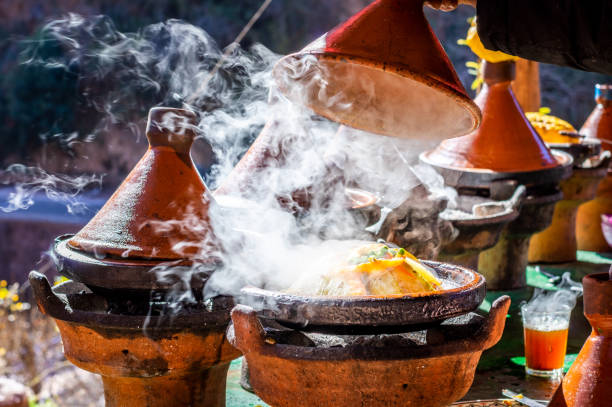
Lamb is the ideal meat for a tagine because it has a natural sweetness that complements the spices in the meal.
I used chopped lamb shoulder – a cut with a little fat that would become deliciously soft during cooking.
You may alternatively use lamb neck or sliced leaner leg steaks for a lighter stew.
TAGINE MOROCCO INGREDIENTS
Aside from the lamb, this dish relies heavily on pantry staples like canned chickpeas and diced tomatoes, as well as onions, garlic, and vegetable stock.
The combination of pleasantly warming spices — cumin, turmeric, cinnamon, and paprika – that make tagines so delectable completely transforms these common foods.
Dried fruit adds a touch of sweetness and binds everything together; I used apricots, but dates, prunes, or raisins would also work nicely. For a textural contrast and extra flavor, sprinkle with chopped nuts such as pistachios or almonds.
HOW TO MAKE LAMB TAGINE
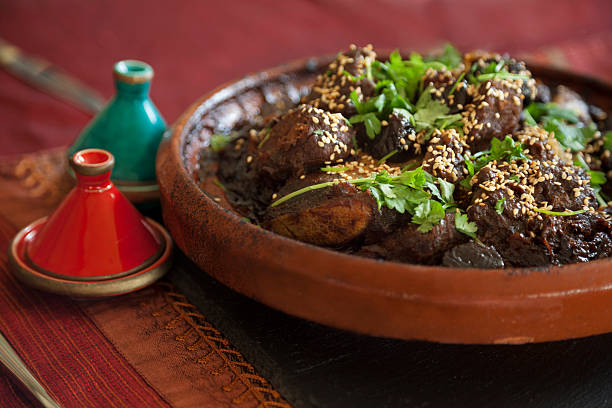
Take a look at this step-by-step instruction — please keep in mind that the whole recipe, including ingredients, can be found in the recipe card at the bottom of this page.
Step 1:
In the pressure cooker, heat the light olive oil and brown the lamb for a few minutes, in batches if required. Set aside. If you are short on time, you may forgo browning the lamb and instead combine it with the remaining ingredients in Step 3.
Step 2:
Deglaze the saucepan with a splash of stock or water if there are any browned pieces at the bottom. Cook for 5 minutes, stirring occasionally until the onion is softened.
Step 3:
Stir in the garlic, ginger, and spices to release the delightful scents.
Step 4:
Add the lamb back to the saucepan and stir to mix. Combine the lemon juice, tomato paste, apricots, and honey in a mixing bowl. To blend, stir everything together.
Step 5:
Stir in the fresh tomatoes, chickpeas, and hot water.
Step 6:
Close the lid, turn the vent to sealing, and cook for 30 min on high pressure. Allow 10 to 15 minutes for natural pressure reduction before manually releasing any leftover heat.
Step 7:
Remove the cinnamon stick. If required, season with salt and pepper. Serve garnished with coriander and chopped pistachios.
SLOW COOKER COOKING ON THE STOVE
The process is fairly similar to the step-by-step description above — merely use a big covered casserole dish and adjust the liquid amounts accordingly.
To cook this dish on the stove, you’ll need two cups (500ml) of stock instead of one. Cook over low heat, stirring periodically and adding extra stock or water as needed.
Follow the stovetop procedure to cook in a slow cooker, but be sure to heed the guidelines on how much liquid to add.
Avoid opening the slow cooker — every time you peek, the heat lowers, increasing the cooking time!
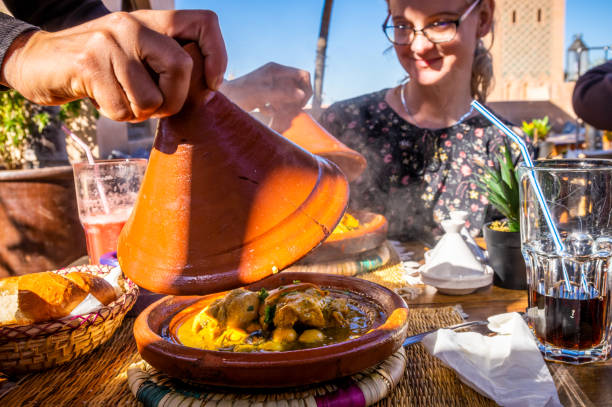
SERVING SUGGESTIONS FOR LAMB TAGINE
Couscous or gigantic couscous is ideal for serving with this stew because they absorb the thick sauce. For a reduced-carb alternative, dish over cauliflower rice.
INSTRUCTIONS FOR STORAGE AND FREEZING
This stew stays nicely in the fridge for some days, with the spices strengthening as it sits. You may also freeze it before garnishing with herbs and nuts.
Take the cinnamon stick and set it aside to cool fully. Freeze in small batches for up to three months. Defrost overnight in the refrigerator and reheat until boiling before serving.
Ingredients
- 2 tbsp mild olive oil for frying
- 1.3 kilogram (3 lb) sliced lamb
- 2 finely diced red onions
- 3 minced garlic cloves
- 1 tbsp grated fresh ginger
- 2 tsp cumin powder
- 4 tsp turmeric powder
- 3 teaspoons sweet paprika
- One cinnamon stick, big
- 150 g | 3 12 oz finely chopped dried apricots
- 2 tablespoons honey (optional)
- 1/2 lemon (juice alone)
- 4 tablespoons tomato paste
- canned chopped tomatoes (400 g | 14oz)
- drained and rinsed 400 g | 14oz tinned chickpeas
- 1 cup heated chicken stock | 250 mL (from a stock cube)
- 3 tablespoons chopped pistachios for garnish
- Garnish with a handful of coriander (cilantro).
instructions for Using an Instant Pot
In your pressure cooker, heat the oil and brown the lamb for a few minutes, in batches if required. Place aside. If you’re pressed for time, skip browning the lamb and instead combine it with the remaining ingredients in Step 3.
Deglaze the saucepan with a splash of stock or water if there are any browned pieces at the bottom. Cook for 5 minutes, or until the onion has softened.
Stir in the garlic, ginger, and spices to release the delightful scents.
Return the lamb to the pot and mix everything.
Combine the lemon juice, tomato paste, apricots, and honey in a mixing bowl. To blend, stir everything together.
Combine the diced canned tomatoes, chickpeas, and stock in a mixing bowl.
Cook for 20 minutes on high pressure with the lid closed and the vent set to sealing. Allow 10 minutes for natural pressure reduction before manually releasing any leftover steam.
Take out the cinnamon stick. If required, season with salt and pepper. Garnish with chopped pistachios and coriander. Serve with couscous or rice as a side dish.
The stovetop approach
In a large covered casserole dish, heat the oil. Cook the onions for 5 minutes, or until softened.
Stir in the garlic, ginger, and spices to release the delightful scents.
Cook for 5 minutes after adding the lamb to the saucepan, stirring to incorporate.
Combine the lemon juice, tomato paste, apricots, and honey in a mixing bowl. To blend, stir everything together.
Add the chopped canned tomatoes, chickpeas, and 2 cups (500ml) stock — this is double the quantity used in the pressure cooker approach.
Bring to a boil, then lower to low heat. Cook, covered, for 1 hour to 1 hour 15 minutes, or until the lamb is cooked and the stew has thickened.
Take out the cinnamon stick. If required, season with salt and pepper. Garnish with chopped pistachios and coriander. Serve with couscous or rice as a side dish.
Notes
You may freeze lamb tagine before adding decorations like herbs and nuts. Take the cinnamon stick and freeze in sections for up to three months. Defrost in the refrigerator and reheat until boiling before serving.

Leave a Reply